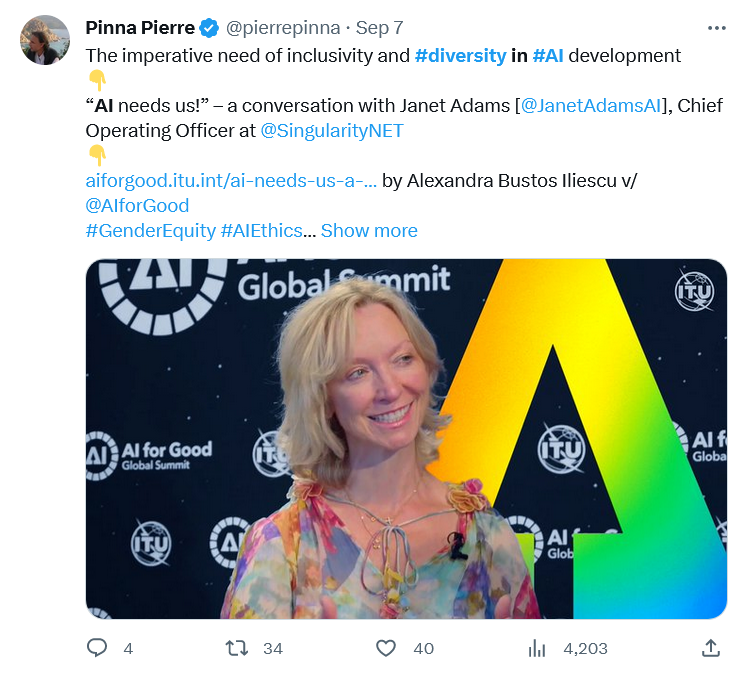Outreach programs – the basis of best practice in future tech development?

• Outreach programs can manifestly improve the diversity of your internal teams.
• Outreach programs help future-proof your company against skills bottlenecks.
• They also help you deliver a much better and broader end-user experience.
Building diversity into tech employment pipelines is the frequently ignored necessity of 2023. There’s a tech skills shortage that goes down to the bones of the education system, and the shortage reinforces traditional stereotypes of what the tech workforce should look like – which is largely white, male, cis and heteronormative. Focusing mostly on this group of candidates is not going to solve the problem.
In Part 1 of this article, we spoke with Caitlin Nowlin, from the software development company Hyland, who has been developing outreach programs to find and inspire new young people to enter the tech industry over a period of years. We asked her about the ways in which the traditional tech pipeline could be expanded, both because of the ongoing skills crisis, but also because it’s the right, 21st century thing to do.
We put it to her that girls and young women are still, in 2023, being discouraged from entering the tech pipeline because of “That’s not for you” attitudes in both the industry and in society in general.
The importance of outreach programs in representation.
THQ:
Talking to lots of women who’ve made their way into leadership roles in tech, one of the things that most of them say is that there’s a process of conditioning by nudges that starts very much earlier than is typically realized, that dissuades girls and young women from coming into the industry. Is that still a thing?
CN:
As you say, the earlier you can get people interested, the less likely that sort of conditioning is to take hold. When we have programs that are designed specifically for girls, we try and get more women teaching them, so that they see that representation, to counter those nudges of negativity with examples that make them think “Oh, there are people in these types of roles that I can look up to as mentors.”
So we definitely make that an important part of the process, when we’re hosting outreach programs that are designed specifically for girls and people who identify as young women.
Tech outreach programs for underrepresented communities.
THQ:
Is that the same sort of approach you use when creating outreach programs for other underrepresented groups of people in the tech sphere?
CN:
Yeah, absolutely. When we’re looking at building outreach programs, we have a two-part goal. Part 1 is to run more outreach programs that reach girls. And Part 2 is to reach students in underserved and underrepresented communities.
We do that in a variety of ways. We host field trips for students – teachers will sign up their class to come to Hyland’s headquarters. We see a lot of schools from the underserved communities of Cleveland and Northeast Ohio come in, and that’s a really great way for us to reach students from those communities.
THQ:
Outreach programs that lead to incomers. Sounds positive, in terms of showing young people exactly what they can expect in the tech industry.
CN:
Yeah, and the outreach programs for underserved communities are evolving, too – we’re really excited because in 2025, we’ll be opening a space in a facility directly in one of those underserved communities in Midtown Cleveland, to be physically closer to students who might be interested.

Transport options in Cleveland are just one issue.
That’s going to be important, because transportation is usually a challenge for students from underserved communities – it’s difficult to run outreach programs that mean anything if the students can’t get to you, or if they can’t make it to your after-school programs. We recognize that, so we’re very excited to have this space where we can physically be closer to those students and try and remove those transportation barriers and have them come to our classes and workshops where we can teach them closer to where they actually are.
READ NEXT

Women in tech: the pipeline problem
THQ:
A kind of permanently established outreach program, there in the heart of underserved communities.
Equalizing the opportunity of access, right?
CN:
Yes, absolutely. That’s very important.
Having a location right there in the community is going to be a game-changer for our outreach programs – it’s actually part of a bigger construction project in the area. We jumped on the opportunity to have a training space and a computer lab on location. It’s gonna be great.
Outreach programs reaching further out.
THQ:
And would there be something you think other companies could learn from your outreach programs and approach?
CN:
Sure. Right now, our outreach programs are only for students in the United States, but because we’re a global company, we’ve received a lot of interest from employees who live outside of the United States to do similar outreach programs.
I’m always willing to talk with people who want to start similar programs. We have a guidebook, and all of the content that we teach students is open-source, so people can teach it in the US. For international outreach programs, it’s just a matter of legality at this point – negotiating the different laws and regulations at work in other countries in regards to working with minors and so on.
But yeah, I’m always willing to give my playbook to people and talk to them, so they can start their own outreach programs if they want to.
The importance of diversity in AI.
THQ:
Where do we go from here? Both in terms of what you’re doing specifically in terms of outreach programs, and the tech industry as a whole with its skills and diversity crises?
CN:
More people need to be doing a similar type of work. It’s really important for leaders, especially, to understand the importance of this type of work, especially the part that is trying to create more representation and add more diverse perspectives to the workforce.
You know, one of the things that is a huge topic right now is AI. It’s very important to make sure that we have people with diverse backgrounds working on that type of technology. And I think that the longer leaders recognize that and continue the work of making sure that there’s diverse representation in the room when they’re working on things like that, the better.

Outreach programs are essential in developing the diverse technology community of the future.
We need to make sure that everyone everywhere is working towards the same goals of creating a more diverse workforce, especially in the technology industry.
THQ:
We’ve spoken to some AI industry people and it’s just dawning on some of them that there’s going to be a significant importance in getting better, broader, more diverse representation into their models, because it’s going to make those models more useful in the wider world.
And there’s no getting away from the fact that if you use some of the models that are currently out there, they’ve been programmed by mostly people of a particular sex, gender, sexuality, color, and so on.

We need as much diversity as possible in the development of generative AI.
CN:
Yeah, and that plays into the user experience. Working for a software company, we have a whole user experience team of researchers and accessibility is a huge thing for us to research. It’s very important that you remember to have the user experience as part of your software development lifecycle. It should be one of the things you’re thinking of before you get started.
If you’re going to do that, you need diverse voices to be heard. And if you need diverse voices to be heard, you need diverse teams to bring you that voice.
How are you going to get them unless you run the outreach programs to bring them in?
Adding diversity to generative AI training will give us a much broader and more useful technology.









